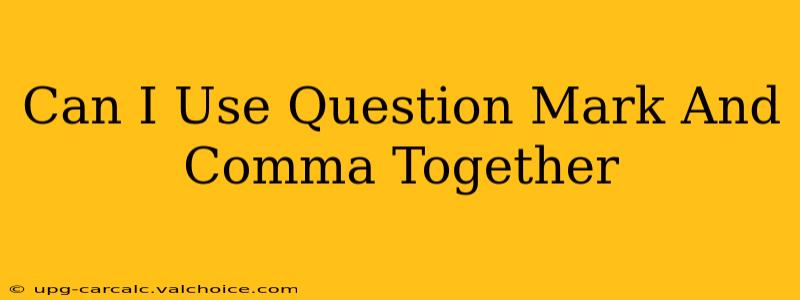Can I Use a Question Mark and a Comma Together? A Guide to Punctuation Precision
The question of whether you can use a question mark and a comma together is surprisingly nuanced. The short answer is: sometimes, but it depends entirely on the context. Let's explore the situations where this combination is appropriate and where it's best avoided.
When a Question Mark and Comma Work Together
The most common scenario where you'll see a question mark followed immediately by a comma is within a list of questions. Consider this example:
- "Do you prefer coffee, tea, or juice, and what's your favorite brand?"
Here, the comma after "juice" acts as a grammatical separator within the list of questions. The final question, "and what's your favorite brand?", is grammatically independent but flows naturally within the overall inquiry.
Another instance where this pairing can work is in more complex sentence structures involving parenthetical elements or embedded questions. For example:
- "Did you finish your work, which, I must admit, surprised me, and are you planning to relax?"
In this case, the comma after "me" sets off the parenthetical aside. While unconventional, the sentence is grammatically correct. However, restructuring the sentence for clarity is often preferable.
When to Avoid Combining Question Marks and Commas
In most cases, placing a comma directly after a question mark is stylistically awkward and grammatically unnecessary. It often signals a poorly constructed sentence. Consider rewriting the sentence to improve clarity and readability.
Example of poor usage:
- "Are you coming to the party, or are you busy?"
This sentence would be much clearer and more concise as two separate sentences:
- "Are you coming to the party? Or are you busy?"
Or even better:
- "Are you coming to the party, or are you busy?" (Here the comma is correct within the single question).
Best Practices for Punctuation Clarity
- Prioritize Clarity: Always choose sentence structure that ensures clear communication. Complex sentence structures with multiple punctuation marks can confuse the reader.
- Rewrite When Necessary: If you find yourself using a question mark followed by a comma, consider if a sentence restructure would improve clarity and readability. Often, breaking the sentence into shorter, more direct sentences is the best solution.
- Consult Style Guides: Refer to established style guides like the Chicago Manual of Style or the Associated Press Stylebook for guidance on punctuation usage in specific situations.
By focusing on clear and concise sentence construction, you can avoid unnecessary punctuation combinations and ensure your writing is easy to understand. Remember, punctuation should serve to enhance readability, not to confuse the reader. So, while technically you can use a question mark and comma together in limited circumstances, strive for simplicity and clarity in your writing.

